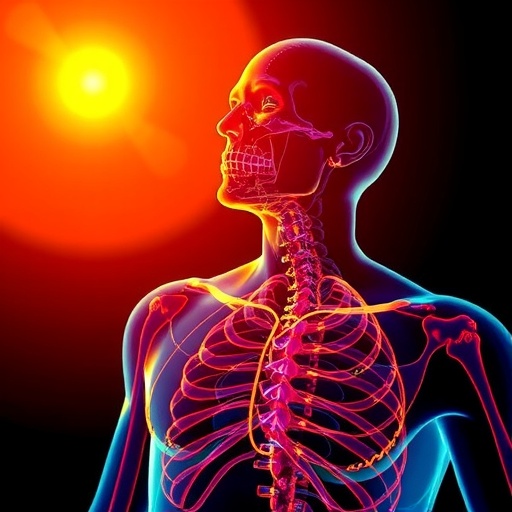In a groundbreaking advancement that could revolutionize the diagnosis and treatment of heatstroke, researchers have employed sophisticated transcriptomics techniques to uncover specific molecular markers linked to severe heatstroke. This discovery promises to deepen medical understanding and open new avenues for therapeutic interventions for a condition responsible for countless fatalities worldwide, especially amid rising global temperatures. The study, published in the International Journal of Legal Medicine, sheds light on the intricate molecular disruptions provoked by severe heatstroke, providing a precise molecular signature that could be instrumental in clinical settings.
Heatstroke, a life-threatening medical emergency caused by an extreme elevation in core body temperature, has long been a critical focus of medical research. Despite its severity, the pathophysiological complexities underlying the condition have remained elusive, hindering prompt and effective management strategies. Traditional clinical indicators have offered limited specificity, making the need for molecular-level markers more urgent than ever. The new research leverages transcriptomics—a powerful approach to assess the complete set of RNA transcripts produced by the genome under specific circumstances—to identify genetic expression patterns unique to severe heatstroke.
Using cutting-edge sequencing technologies, the researchers meticulously analyzed RNA samples extracted from patients who experienced critical heatstroke episodes. By comparing the transcriptomes of these patients with healthy controls, the team pinpointed distinct gene expression profiles that correlate tightly with the severity of heatstroke. This molecular fingerprint not only enhances diagnostic accuracy but also offers insights into the biological pathways most impacted during heat-induced cellular stress. Such insights carry profound implications for both emergency medicine and forensic pathology, where differentiating heatstroke from other causes of sudden death can be challenging.
One of the pivotal findings highlighted in the study is the dysregulation of immune response genes in severe heatstroke patients. These genes exhibited abnormal heightened activity, indicating an exaggerated inflammatory response triggered by hyperthermia. The inflammation cascade, while part of the body’s defensive mechanism, can exacerbate tissue damage, leading to organ failure if unchecked. By identifying specific cytokine signaling pathways affected during heatstroke, the researchers have mapped the molecular underpinnings that fuel systemic inflammation, illuminating targets for potential therapeutic modulation.
Further analysis revealed significant alterations in genes associated with cellular stress responses, particularly those involved in protein folding and repair mechanisms. Heatshock proteins, which act as molecular chaperones to protect cells from thermal damage, were found to be markedly overexpressed in the transcriptomic data. This upregulation underscores the body’s attempt to salvage damaged proteins and maintain cellular integrity under extreme conditions. Understanding the dynamics of heatshock protein gene expression provides a molecular window into the cellular survival strategies deployed during heatstroke.
Moreover, the study unveiled a striking suppression of genes involved in mitochondrial function and energy metabolism, revealing a critical disruption in cellular bioenergetics. Mitochondria, often dubbed the “powerhouses” of the cell, are central to energy production and metabolic regulation. Their impairment during heatstroke suggests a severe energetic crisis that may contribute to multiorgan dysfunction. The identification of key mitochondrial molecular markers not only informs the pathophysiology but also highlights potential biomarkers for early detection of organ damage in heatstroke patients.
Beyond the diagnostic realm, these transcriptomic insights can steer the development of targeted therapies aimed at mitigating the detrimental molecular cascades triggered by heatstroke. For instance, modulating inflammatory pathways or enhancing heatshock protein function pharmacologically could attenuate tissue injury and improve patient outcomes. The molecular markers unearthed through this research could also serve as biomarkers to monitor therapeutic responses, enabling more personalized and adaptive treatment approaches for heatstroke victims.
Importantly, this study’s methodology heralds a new era in forensic medicine, where molecular signatures detected post-mortem can definitively confirm heatstroke as the cause of death. Such precision is invaluable in legal contexts, where determining the circumstances of death must meet rigorous evidential standards. The capability to identify specific RNA expression profiles unique to severe heatstroke equips forensic experts with a powerful tool to resolve ambiguous cases and strengthen accountability in heat-related fatalities.
The implications of these findings extend beyond the clinical and forensic settings into public health and occupational safety domains. As heatwaves intensify and incidents of heatstroke escalate globally, understanding the molecular basis of severe heatstroke is crucial to formulating preventive strategies and early intervention protocols. The research furnishes a biological framework that can guide the design of biomarkers for rapid field testing and risk assessment in vulnerable populations, including outdoor workers, athletes, and the elderly.
This pioneering research also underscores the transformative potential of transcriptomics in uncovering complex disease mechanisms. By capturing a comprehensive and dynamic portrait of gene activity, transcriptomics transcends traditional reductionist approaches, offering an integrated view of cellular and systemic responses under pathological stress. The researchers advocate for the broader incorporation of omics technologies in heat-related illness studies to expedite biomarker discovery and accelerate translational applications.
While the study marks a significant leap forward, the authors acknowledge the need for further validation in larger and diverse cohorts. Exploring the temporal evolution of gene expression throughout the heatstroke progression and recovery phases will provide deeper insights into disease dynamics. Additionally, integrating transcriptomic data with proteomic and metabolomic analyses promises a multi-dimensional understanding that could illuminate novel therapeutic targets and prognostic indicators.
In summary, the identification of specific molecular markers for severe heatstroke using transcriptomics is a landmark accomplishment that bridges molecular biology and clinical practice. Beyond enhancing diagnostic precision, it offers a mechanistic glimpse into the catastrophic cellular events ignited by extreme heat stress. As heatstroke continues to pose escalating clinical and societal challenges, these molecular revelations pave the way for breakthroughs in prevention, diagnosis, treatment, and forensic investigation.
The intersection of innovative sequencing technologies and urgent medical needs exemplifies the future of precision medicine, where molecular profiling drives tailored interventions and improved health outcomes. This study not only provides a molecular blueprint for severe heatstroke but also inspires a paradigm shift in how we comprehend and confront heat-induced pathologies in an era defined by climate change and rising temperatures.
Driven by this research, the scientific community is poised to unlock new layers of biological complexity underlying heatstroke and harness this knowledge to save lives. As knowledge evolves, so too will therapeutic and diagnostic landscapes, translating molecular breakthroughs into tangible benefits for patients and societies worldwide. This is a striking testament to the power of molecular medicine combined with visionary scientific inquiry.
Subject of Research: Molecular markers in severe heatstroke identified through transcriptomics techniques
Article Title: Identification of specific molecular markers in severe heatstroke using transcriptomics techniques
Article References:
Duan, Z., Wang, M., Zhou, Y. et al. Identification of specific molecular markers in severe heatstroke using transcriptomics techniques. Int J Legal Med (2025). https://doi.org/10.1007/s00414-025-03634-8
Image Credits: AI Generated
Tags: clinical implications of heatstroke researchgenetic expression in heat-related illnessesimpact of global warming on healthinnovative approaches to heatstroke managementlife-threatening medical emergenciesmolecular markers of heatstrokepathophysiology of heat-related conditionsRNA sequencing technologies in medicinesevere heatstroke diagnosis advancementstherapeutic interventions for heatstroketranscriptomics in medical researchunderstanding heatstroke mechanisms





